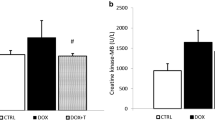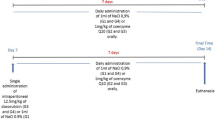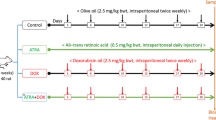Abstract
The hypothesis that copper (Cu) alters drug metabolizing enzymes and functions as an antioxidant nutrient in doxorubicin cardiotoxicity was tested. Male Sprague-Dawley rats were fed Cu adequate (+Cu; 5 mg Cu/kg of diet), marginally Cu deficient (MCu; 1.2 mg Cu/kg of diet), or severely Cu deficient (−Cu; 0.5 mg Cu/kg of diet) diets for 6 wk. Doxorubicin (1, 2, or 4 mg/kg body wt) or saline were administered intraperitoneally 1 time/wk for 4 wk. Compared to control hearts, Cu, Zn superoxide dismutase activity was decreased by 9% in MCu rats and by 21–40% in−Cu rats. Glutathione peroxidase activity was elevated 5–15% in−Cu rats. Doxorubicin administration increased heart Cu, Zn superoxide dismutase activity in+Cu and−Cu rats 18 h after the last of 4 injections, but not 18 h after 1 injection. There was no synergism between doxorubicin and Cu deficiency on lipid peroxidation, plasma creatine phosphokinase, cardiac hypertrophy, electrocardiographic abnormalities, or morphological changes. Heart glutathione S-transferase activity was decreased by Cu deficiency, and like Cu, Zn superoxide dismutase activity, returned to normal in−Cu rats given doxorubicin. Thus, the Cu deficient rat heart may be able to compensate for doxorubicin-induced oxidant stress by increasing the activity of Cu,Zn superoxide dismutase and glutathione S-transferase.
Similar content being viewed by others
References
J. T. Saari and D. M. Medeiros.Biol. Trace Elem. Res. 31, 249 (1991).
P. K. Singal, C. M. R. Deally, and L. E. Weinberg.J. Mol. Cell. Cardiol. 19, 817 (1987).
J. Fischer, M. A. Johnson, and R. L. Tackett.Toxicol. Lett. 57, 147 (1991).
J. G. Fischer, R. L. Tackett, E. W. Howerth, and M. A. Johnson.J. Nutr.,122, 2128 (1992).
J. D. Hammermueller, T. M. Bray, and W. J. Bettger.J. Nutr. 117, 894 (1987).
G. Powis.Metabolism and Action of Anti-Cancer Drugs, G. Powis and R. A. Prough, eds., Taylor and Francis, London, 1987, pp. 211–260.
M. A. Johnson and C. L. Murphy.Am. J. Clin. Nutr. 7, 96 (1988).
J. A. Buege and S. D. Aust.Methods in Enzymology 52, 302 (1978).
D. I. Paynter.Biol. Trace Element Res. 2, 121 (1980).
D. E. Paglia and W. W. Valentine.J. Lab. Clin. Med. 70, 158 (1979).
K. H. Schosinsky, H. P. Lehmann, and M. F. Beeler,Clin. Chem. 20, 1556 (1974).
M. A. Johnson and C. L. Murphy.Biol. Trace Elem. Res. 17, 69 (1988).
H. Aebi,Methods of Enzymaic Analysis, vol. 3, H. U. Bergmeyer, ed., Verlag Chemie, Weinhein, 1983, pp. 273–285.
W. H. Habig, M. J. Pabst, and W. B. Jakoby.J. Biol. Chem. 193, 265 (1974).
D. M. Williams, R. F. Burk, S. G. Jenkinson, and R. A. Lawrence.J. Nutr. 111, 979 (1981).
T. Omura and R. Sato.J. Biol. Chem. 239, 2379 (1964).
O. H. Lowry, N. J. Rosebrough, A. L. Farr, and R. J. Randall.J. Biol. Chem. 193, 265 (1951).
K. Asaoka and K. Takahashi.J. Biochem. 90, 1237 (1981).
M. A. Johnson.J. Nutr. 116, 802 (1986).
SAS Institute Inc. (1985),SAS User's Guide: Statistics, Version 5 Edition, SAS Institute Inc., Cary, NC, 1985, pp. 1–956.
J. Davidson, D. M. Medeiros, and R. L. Hamlin.J. Nutr. 122, 1566 (1992).
D. M. Medeiros, D. Bagby, G. Ovecka, and R. McCormick.J. Nutr. 121, 815 (1991).
D. M. Medeiros, Z. Liao, and R. L. Hamlin.J. Nutr. 121, 1026 (1991).
R. D. Olson and P. S. Mushlin.FASEB J. 4, 3076 (1990).
M. A. Johnson, J. G. Fischer, and S. E. Keys.Crit. Rev. Food Sci. Nutr. 32, 1 (1992).
J. H. Doroshow, G. Y. Locker, and C. E. Myers.J. Clin. Invest. 65, 128 (1980).
R. D. Olson, J. S. MacDonald, C. J. van Boxtel, R. C. Boerth, R. D. Harbison, A. E. Slonim, R. W. Freeman, and J. A. Oates.J. Pharmacol. Exp. Ther. 215, 450 (1980).
W. D. Wosilait and M. P. Ryan.Res. Comm. Chem. Path. Pharm. 56, 335 (1987).
C. E. Myers, L. Gianni, C. B. Simone, R. Klecker, and R. Greene.Biochemistry 21, 1713 (1982).
W. T. Johnson and T. R. Kramer.J. Nutr. 117, 1085 (1987).
S. K. Jain and D. M. Williams.Am. J. Clin. Nutr. 48, 637 (1988).
B. C. Lee. University Microfilms International, Ann Arbor, MI. (1985).
Author information
Authors and Affiliations
Rights and permissions
About this article
Cite this article
Fischer, J.G., Tackett, R.L., Howerth, E.W. et al. Copper deficient rat heart can compensate for doxorubicin-induced oxidant stress. Biol Trace Elem Res 37, 233–251 (1993). https://doi.org/10.1007/BF02783798
Received:
Accepted:
Issue Date:
DOI: https://doi.org/10.1007/BF02783798




